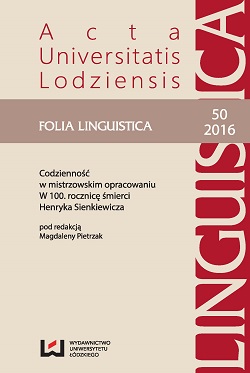Wyobrażenie miasta i mieszczaństwa w języku Sienkiewiczowskiej Trylogii
The image of city and townspeople in Sienkiewicz’s Trilogy
Author(s): Iwona Pałucka-CzerniakSubject(s): Lexis, Polish Literature
Published by: Wydawnictwo Uniwersytetu Łódzkiego
Keywords: lexis; historical novel; city; middle class; stereotyping; innovation;
Summary/Abstract: The aim of this paper is to reconstruct the image of the role of the city and bourgeoisie in the seventeenth century, settled in the Trilogy of Henryk Sienkiewicz. The lexemes naming the city appear in the definitions of the various terms of space, they serve its scratching. The reader, however, must complement a spatial arrangement drawn up by the storyteller. Imaging the city is followed by the exploitation of key words, which name the elements of the architecture of the city. The lexemes specifying the residents of the city, their activities and competitions appear sporadically. Quite often H. Sienkiewicz exploits anthropomorphisation efforts and metonymy, applied to the conceptual category of the city, which allows to talk about the features and social functions of the middle class. The lexicon associated with the city shows that, seen from the perspective of a noble, is a symbol of a self-sufficient residence that fills many needs of a noble: it provides money, soldiers, goods, serves as a refuge in times of war or bad weather, can resist the invaders. A noble point of view of the narrator is also expressed in attention to a defensive function of the city and the brave or cowardly attitudes of townspeople. A full overview of the lexical resource serving the definition of the city and the bourgeoisie reveals, in addition to standard and repetitive efforts also non-standard ones, breaking stereotypes, heterogeneous and difficult to classify. It is manifested in the exis by a large group of colocations, which occur at a time. Language creation of the middle class is on the one hand firmly schematic, and surprisingly unique on the other hand.
Journal: Acta Universitatis Lodziensis. Folia Linguistica
- Issue Year: 2016
- Issue No: 50
- Page Range: 75-89
- Page Count: 15
- Language: Polish

